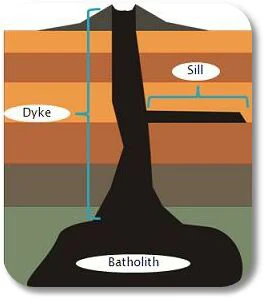Forms of Igneous Rocks (Igneous Bodies)
Concordant and Discordant Forms of Igneous Rocks
Igneous intrusions are classified based on their relationship to the pre-existing rock layers (country rocks). These intrusions can either conform to or disrupt the layering of the surrounding rocks, giving rise to concordant and discordant forms.
---
Concordant Forms
Concordant intrusions occur when magma is injected along bedding planes or between layers of pre-existing rocks, aligning with the natural structure without significantly disturbing it.
1. Sills
Definition: Thin, horizontal sheets of magma that solidify parallel to the bedding planes.
Formation: Formed when magma intrudes between sedimentary or other layered rocks under low pressure.
Characteristics:
Typically uniform in thickness.
May vary in composition (basaltic sills are common).
---
2. Laccoliths
Definition: Dome-shaped intrusions where magma pushes the overlying layers upward, forming a convex structure.
Formation: Result from magma of high viscosity (e.g., granitic magma) that pools and lifts the overlying layers.
Characteristics:
Flat base and domed top.
Often associated with volcanic activity.
---
3. Lopoliths
Definition: Basin-shaped intrusions where the magma pools and causes the overlying layers to sag downward.
Formation: Typically formed by dense, mafic magma.
Characteristics:
Convex downward shape.
Large in size, often associated with layered mafic complexes.
---
Discordant Forms
Discordant intrusions occur when magma cuts across the bedding planes or layers of the country rock, disrupting their natural arrangement.
1. Dikes
Definition: Vertical or steeply inclined sheets of magma that cut across pre-existing rock layers.
Formation: Formed when magma forces its way through fractures or faults in the rock.
Characteristics:
Typically narrow but can be very long.
Often found in swarms (multiple dikes in a region).
---
2. Batholiths
Definition: Massive, irregularly shaped intrusions that form deep within the Earth's crust.
Formation: Result from the slow cooling and solidification of large volumes of magma.
Characteristics:
Extremely large (covering hundreds of square kilometers).
Composed mainly of granitic rock.
Often exposed at the surface due to erosion of overlying material.
---
3. Volcanic Necks (Plugs)
Definition: Hardened magma within the vent of an extinct volcano, exposed after the surrounding volcanic material is eroded.
Formation: Forms when magma solidifies within the throat of a volcano.
Characteristics:
Resistant to erosion.
Often steep and prominent.
---




Comments
Post a Comment